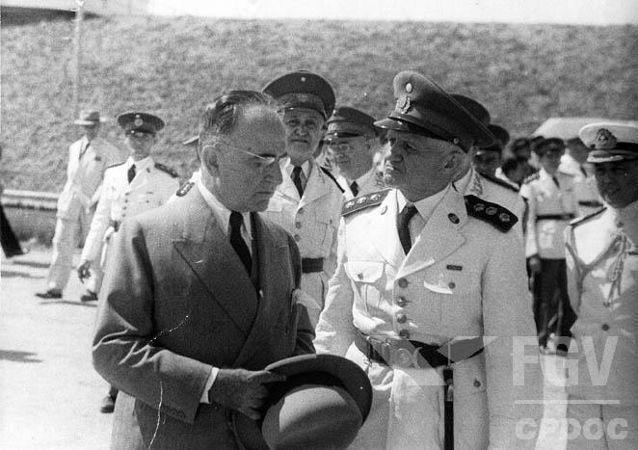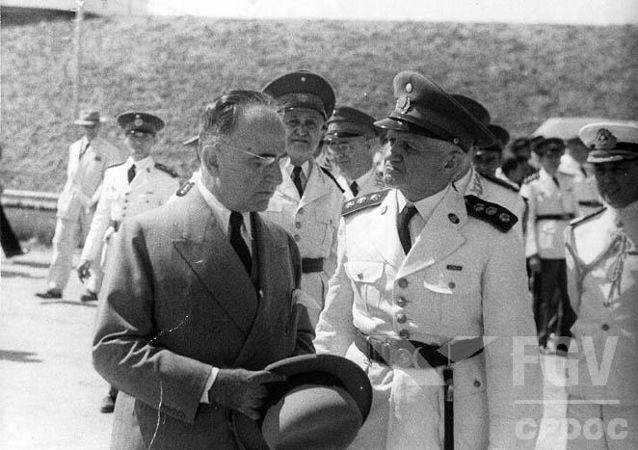O stateNew it was one of the phases of the period in which Getúlio Vargas was in the presidency of Brazil. This was the dictatorial phase of his government and extended from 1937 to 1945, having as great marks the censorship and the repression to opposing groups. This dictatorship was started through a self-coup that happened with the dissemination of the Cohen Plan, and it only ended when the military forced Vargas to resign.
Also access: See the main events of the Vargas government before the Estado Novo
Beginning of the New State

The Estado Novo emerged in 1937, when Vargas held a self-coup with the granting of a new Constitution for Brazil. This dictatorial phase of his regime, however, was the result of a process in which he promoted an increasing centralization of power in his hands. In other words, the authoritarian regime was built by Vargas throughout the 1930s.
since your rise to power, Vargas demonstrated an inclination towards the
authoritarianism and to the centralization of power. Upon taking over as provisional president, he sought to postpone the holding of a presidential election and the drafting of a new Constitution for Brazil. Anyway, under pressure, he ended up giving in, so an indirect election was held and a new Constitution was promulgated in 1934.the dictated phase Constitutional (1934-1937) was, in fact, the period in which Vargas carried out the greatest number of actions to build the authoritarianism, since the law at the time stipulated that he could not run for re-election in the election presidential election of 1938. Thus, Vargas found in the “threatcommunist” the perfect excuse to remain in power in Brazil.
This argument started to be explored by him, mainly from 1935, when it happened in Brazil the intentCommunist, the failed coup attempt carried out by the communists of the AllianceNationalliberator. This event gave Vargas strength and, according to historian Thomas Skidmore, allowed him to convince part of the elite that the country's solution was an authoritarian government.|1|
Among the measures taken during this period and that contributed to the construction of authoritarianism, is the decree of National Security Law, on March 30, 1935 (thus, before the Communist Intentona). This law gave the government broad powers to combat “subversive activities” that undermined the “social order”.
Furthermore, the fear of the action of communist groups in the country was so great that the Brazilian Congress granted Vargas the broad powers he desired. When Intentona happened, the situation got worse. Vargas managed to approve the stateinPlace, the National Security Law was toughened, and other authoritarian laws were passed.
In addition, the police began to rely on the connivance of the authorities to use of torture as a form of repression to the movements of the left and opposing forces. The government also created, in 1936, the National Security Court, which rigidly condemned those who were framed in the National Security Law.
As mentioned, Vargas' great achievement was that he managed to convince the middle and upper classes, as well as the Army itself, that the path to modernization of the country it's the fighting communism required the implementation of a authoritarian regime. Thus, these two groups supported and their representatives actively participated in the coup.
Cohen Plan
This hardening and closing of Brazil resulted in the New State coup in November 1937. Vargas used the dissemination of the FlatCohen as a strategy to implement the authoritarian regime. The Cohen Plan was released in September 1937 and consisted of a fake document that talked about a communist uprising brewing in the country.
This false document ended up being exploited by the government to create a climate of panic in the country. In October, constitutional rights were suspended, and in November came the coup. On November 10, army troops surrounded Congress, an authoritarian constitution was granted (imposed), and Vargas annulled the presidential election that would take place in 1938.
These events started the Vargas dictatorship known as stateNew. The coup that took place in Brazil was supported by many parliamentarians and had crucial support from elements of civil society and the Armed Forces. Some names that supported him were Góes Monteiro, Francisco Campos, Olímpio Mourão, among others.
Also access:The Estado Novo economic and housing development program
Characteristics and achievements of the Estado Novo
The Estado Novo was in accordance with the tendency of political authoritarianism that existed in the world of the 1930s. Since the 1920s, a series of authoritarian regimes had been implemented in different nations, and, in the case of Brazil, the Estado Novo was built with the inspiration of the fascism, implemented in Italy, and the salazarism (also known as Estado Novo) in Portugal.
Despite the ideological inspiration, Thomas Skidmore suggests that the Estado Novo was a personal construction of Getúlio Vargas.|2| The great brand of the Estado Novo was the centralizationofpower, as this, which was previously divided between the Federal Government, states and municipalities, came to be concentrated in the hands of Vargas and the Federal Government.
The Legislature, of course, was weakened. This is easily identifiable since, on the day of the coup, Congress was encircled and closed. At assembliesstate and chambersmunicipal also wereclosed with the beginning of the Estado Novo. Government intervention also took place in the Executive, through the appointment of interventors to govern the Brazilian states.
These events reinforce what was mentioned. Important assignments that were previously in the hands of states and municipalities were transferred to the Federal Government, and Vargas' intervention in the state governments contributed to strengthening their power, as the appointment of interventors took into account the support they provided to the government.
The centralization of power in all possible spheres guaranteed Vargas broad powers It is huge political negotiation skills. The authoritarian leader intervened in the economy, politics and administration of the country in a broad way. His form of government was responsible for the weakening of the oligarchies and regionalisms that still existed in the country.
Vargas sought to economically integrate the nation, and, for that, encouraged the economic and housing/population development of poorly integrated places, such as the North and the Center-West. In addition, he had the pride (extreme nationalism) a great tool for political propaganda, as his government, through many intellectuals of the time, sought to reinforce the feeling of Brazilian belonging.
there was a strong political advertising what highlighted the achievements of the government and omitted the criticisms made by the opposition. Both political advertising and censorship were the work of the Press and Advertising Department (DIP). It also promoted a kind of cult of Vargas' image, through publications in magazines and newspapers and also on the radio.
Finally, Vargas fought the existence of a political system in the country, and this can be seen in the fact that there were no Brazilian political parties during the Estado Novo. Same political groups that supported Vargas were persecuted and repressed during this period, as was the case of the integralists.
Know more:What is totalitarianism?
Estado Novo and the workers

In the 1940s, especially after 1942, Getúlio Vargas realigned his policy and sought to gain a new base of support. That readjustment in political strategy de Vargas was very well thought out, once he realized that with the Second war, the maintenance of a dictatorial regime was impracticable.
From this strategic readjustment of Vargas, the labor, a political practice that defended an intense role of the State in the economy and focused on the creation of legislation that granted rights that had not existed until then for the working class. Vargas' goal was ensure the support of workers in case a new democratic regime emerged in the country.
With that, a series of labor rights were created by him in the final years of his dictatorship. Among the highlights, the creation of the JusticeofWorkin 1939; the decree of minimum wage, in 1940; and the creation of Consolidationof thelawsofWork, in 1943. Vargas also expanded the country's social security and union legislation and realigned his speeches, with workers as his main target.
Also access: Understand one of the most troubled episodes in the history of the republic in Brazil
End of the New State
The end of the Estado Novo is directly related to two events: the involvement of Brazil in World War IIand the Vargas' approximation of workers. In the first case, Brazil declared war on the Axis in 1942, after carrying out diplomatic negotiations with the United States that included economic benefits for that country.
Brazil's involvement in World War II created a great contradiction, as the government had sent soldiers to fight for democracy in Europe, but here it maintained a dictatorship. In the case of labor policy, the issue involved the government's bases of support: the military.
Vargas' approach to workers bothered the military and part of the economic elite that supported the government. Alignment with unions and workers was seen with great suspicion, and this led Getúlio to be attacked by these groups. The demand for a democratic regime in the country became noticeable with the Miners' Manifest, a document that demanded more democracy in the territory.
Vargas even tried to get around the situation by taking measures that promoted a certain political opening of the country, and thus the founding of political parties was allowed and a presidential election was called for 1945. Vargas' idea was remain in power, but this time through a democratic regime.
His strategy did not work, and the strain on Vargas' relationship with the military was so great that, on October 29, 1945, they carried out a ultimatum demanding the renounce of the president. Vargas resigned and the next day he was on his way to his native Rio Grande do Sul.
After his resignation, Brazil was ruled on an interim basis by José Linhares, president of the Superior Electoral Court, until January 31, 1946. In the three-month period in which he was in power, the election was held that placed Eurico Gaspar Dutra as president of Brazil. This started a new phase of the Brazilian Republic, known as Fourth Republic.
Also access: Find out how the second government of Getúlio Vargas was
Grades
|1| SKIDMORE, Thomas E. Brazil: from Getúlio to Castello (1930-64). São Paulo: Companhia das Letras, 2010, p. 54.
|2| Idem, p. 64.
Image credit
[1] FGV/CPDOC
[2] FGV/CPDOC

